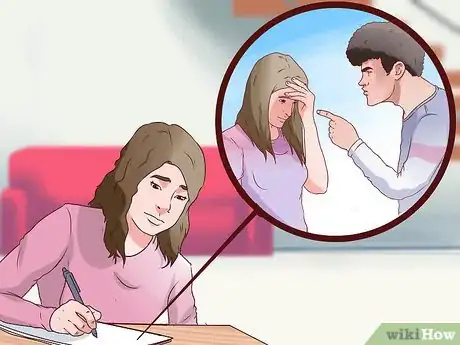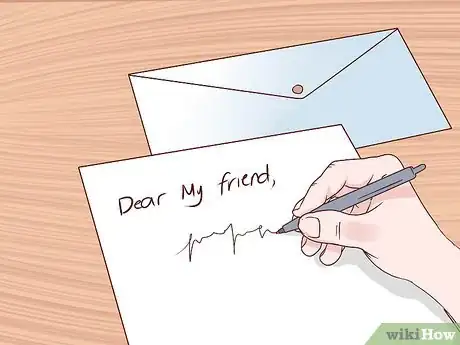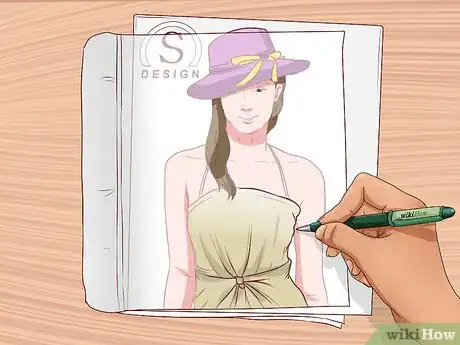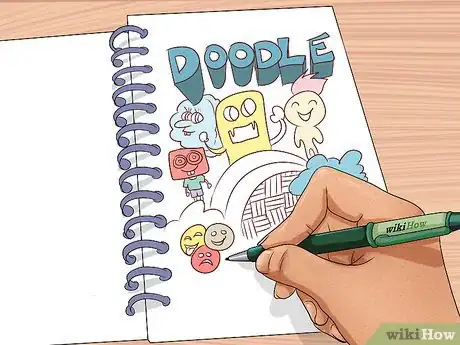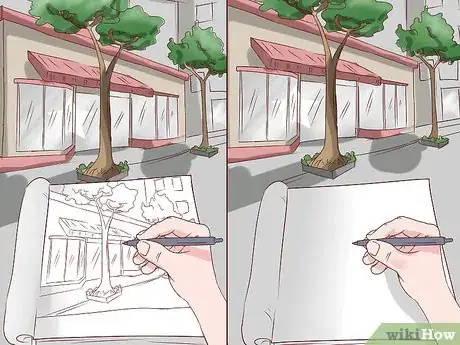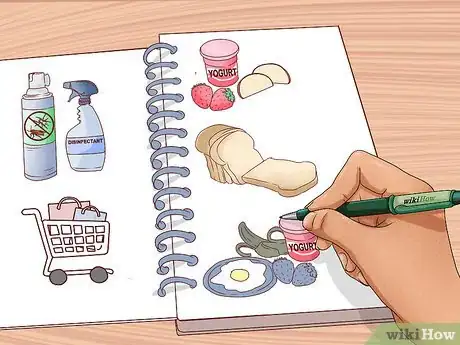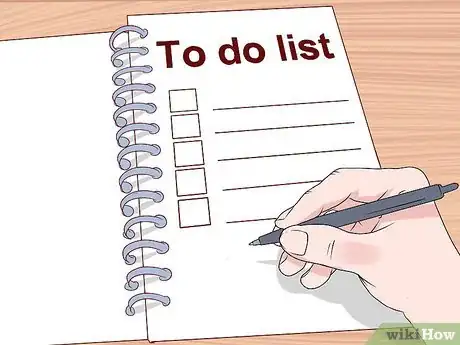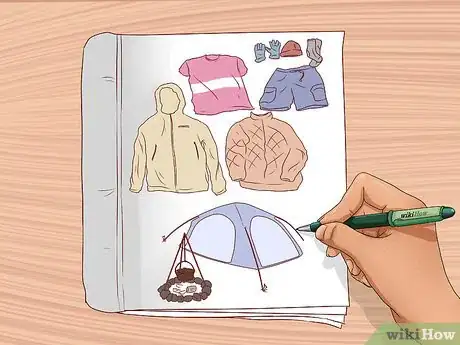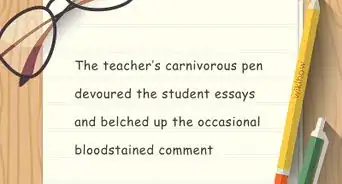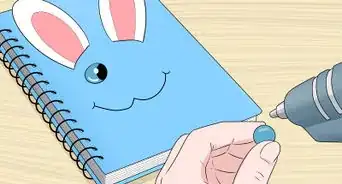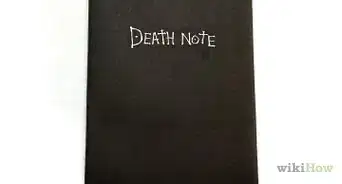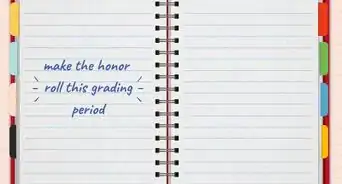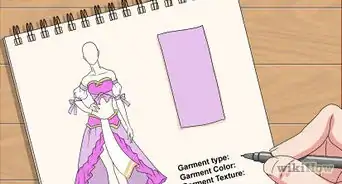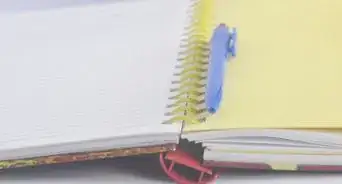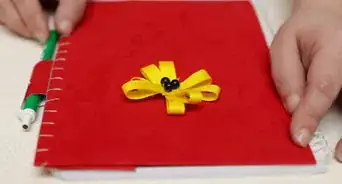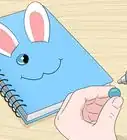X
This article was co-authored by wikiHow Staff. Our trained team of editors and researchers validate articles for accuracy and comprehensiveness. wikiHow's Content Management Team carefully monitors the work from our editorial staff to ensure that each article is backed by trusted research and meets our high quality standards.
This article has been viewed 172,629 times.
Learn more...
Use the blank spaces in your notebooks. You might have a notebook that’s only half full due to an old class or an unfinished project. You may even feel inspired to fill a brand new notebook. Regardless of the reason, you shouldn’t let the notebook paper go to waste. There are several things you can do to fill up a notebook.
Steps
Method 1
Method 1 of 3:
Using the Notebook as a Diary or Journal
-
1Commit to a daily routine. Be realistic with yourself while planning to utilize your notebook. If you commit to writing in the notebook everyday, you can fill it up in no time. Think about a time of the day that would be best for writing. If you have a busy morning and afternoon, write each night before going to sleep.
- Once you block a time during your day for writing, it is important to stick with it. You can better utilize your notebook if you stay committed to your goals.[1]
- It will feel good to complete something you set out to accomplish.
-
2Write about your day. An easy thing to write about is your day and what you accomplished or failed to accomplish. Writing about your day will also challenge your memory and improve it over time.
- Give yourself a time buffer before reflecting about an event. Say you go to sleep at night, wake up in the morning, and then write about your day.
- Date each entry as you go for future reference. You might get into a dispute about when you first kissed your girlfriend. By dating an entry, you can easily pick out the exact date something occurred.
Advertisement -
3Write about your fantasies. Your imagination is a great way to utilize your notebook. If you find yourself bored and daydreaming, jot down the scene as best to your abilities. Writing down your fantasies is also a good way to explore your creative side.
- You don’t need to write about dragons, unless you like imagining a world with dragons.
- If you have a dream about living in South America, explore those thoughts by writing about the details.
- You don’t need to write a structured short story. Focus on the specific details in your head. If you want to develop your entry into a story, you have a series of details to use.
-
4Explore an issue that’s bothering you. Writing oftentimes can relieve a problem you’re facing in life. Look at the history of poets and writers, who have explored great pain and pleasure in a beautiful arrangement of words. They’re using writing as a form of self therapy by being introspective and in touch with their emotions.
- You can write about a family member’s passing, a break-up, or even unrequited love.
- Expose your feelings and don’t concern yourself with other people reading your thoughts.
-
5Write a letter. Writing letters can benefit you in several ways. You can actually write a letter to a friend or family member using your blank notebook paper. Alternatively, you could write a letter to someone you are frustrated with and not send it to them. It may seem old fashioned, but you can still utilize the gratification of writing a letter to someone.[2]
- People enjoy receiving physical mail that isn’t junk mail.
-
6Use your notebook as a friendship journal. You and a good friend or group of friends can take turns writing in the notebook. Hold onto the notebook for a week at a time and then pass it on. You can use the friendship journal to tell your friends thoughts and ideas you experience. This can also be a great way to become closer with your friends.
- You could even use the friendship notebook to create a story where each of you contributes a chapter at a time.
- The same idea could even be used to create a comic book.
-
7Use your notebook as a dream journal. When you wake up each morning, write down the dreams you had right away so you don't forget them! Dreams typically last in your memory during the first ten minutes you wake up. Utilize this time and write out the dream. You will find that over time you will become better and better at remembering your dreams.
- Some researchers have even concluded that dream journals will increase the amount you dream and remember it.[3]
Advertisement
Method 2
Method 2 of 3:
Creating a Sketchbook Out of Your Notebook
-
1Determine how much space is available. You can utilize your notebook as a notepad for drawing. The size of the paper and amount of used space will effect what you can draw. If your notebook is a pocket sized notebook, you can still draw detailed doodles. It helps if you have good pens to draw with.
- If the notebook is filled words, but there is only a line or two, you can still draw on each page.
-
2Draw things out in public. Bring your notebook out in public and draw things around you. Find a nice park bench with a good view and look for something to draw. You could also go somewhere like a coffee shop and draw something in your sight.[4]
- Be cautious if you choose to draw people in public. Some people may find it uncomfortable, so ask permission.
-
3Attempt to draw from a magazine. You can find thousands of images from magazines and other books. Rather than trace over an image you like, try to draw it from studying the image. This will improve your drawing skills more than tracing an image.
- Nature magazines will have plenty of scenes that are perfect for practicing.
-
4Doodle on the page. Instead of taking your drawings too seriously, try to jot down some doodles to fill a page. Even if you have notes on a page, you can doodle in the blank spaces. Fun things you can doodle are band logos, symbols, geometric shapes, cats/dogs, faces, and swords. You can doodle anything you think of.[5]
- Experiment with ideas in your head, or just draw for the fun of it.
-
5Practice a drawing you want to improve. If you are an aspiring artist or illustrator, you can practice drawing an image you want to improve. It is good for artists to draw multiple versions of the same object. This will give you variations to choose from. Once you draw an iteration you’re especially pleased with, you can transfer that image to canvas or another medium.
- Repetition is a great way to improve your drawing skills. By repeating the same image, the process becomes ingrained into your brain.
-
6Create collages. Cut out images from magazines or books and create collages in your notebook. Collages are an easy way to create an artistic image. You need scissors and some glue. Cut out multiple images from a magazine like a golfer, a mountain range, or a bulldog. Then arrange them in your notebook.
- Once you find an interesting composition out of your cutouts, glue them into your notebook.
- Old National Geographic magazines are great for making collages.
Advertisement
Method 3
Method 3 of 3:
Utilizing Your Notebook for Daily Notes
-
1Write down your grocery list. Don’t get stuck at the grocery store without a clue about what you should buy. Check your pantry and refrigerator to determine what groceries you need. Use your notebook to write out a list of ingredients you need.
- If you plan to cook a recipe, check what supplies you already have before purchasing additional ingredients.
-
2Plan out a to-do list. To-do lists can turn your hectic work week into an organized and approachable obstacle. If you constantly feel the pressure of not utilizing your time, write out tasks and goals on paper. Even the act of writing an event will reinforce the task at hand into your head.[6]
- You can write a list for a single day, the day ahead, or even a full rundown of your week.
-
3Write a list and itinerary for a trip. When you are planning to go on a trip, it helps to write out everything you need. Don’t be that person who forgets their toothbrush. You could also benefit from writing out a detailed itinerary of your trip. Keep the notebook somewhere you’ll check it.
- Follow through with your notes about your trip. If you wrote down "change the oil before leaving," do it!
-
4Use the notebook for schoolwork. One of the classic uses of a notebook is for homework and school notes. Stay on top of your studies and you will fill a notebook in no time. If you finish a semester of work and haven’t filled the entire notebook, save it for next semester.
- Reuse your notebook to save money and to fully utilize your notebook.
Advertisement
Community Q&A
-
QuestionWhat should I write as an introduction?
 Goldenrose4Community AnswerIt would be a good idea for an introduction to tell a little bit about yourself. For example, your name, current age, interests, current sports or activities that you're doing, anything like that. It's your notebook, so make it feel like your own.
Goldenrose4Community AnswerIt would be a good idea for an introduction to tell a little bit about yourself. For example, your name, current age, interests, current sports or activities that you're doing, anything like that. It's your notebook, so make it feel like your own. -
QuestionWhat could I do if I have only lined notebooks, and I don't want to do a diary or journal?
 Community AnswerDo a dream journal, a pen swatches notebook, make lists of mini successes, write poetry and songs, write letters to your future self, or compile lists of new words to learn.
Community AnswerDo a dream journal, a pen swatches notebook, make lists of mini successes, write poetry and songs, write letters to your future self, or compile lists of new words to learn. -
QuestionCan I put a story in my notebook?
 Community AnswerOf course. You could write about a true story or use your imagination. You can write an entire novel in it if you want to.
Community AnswerOf course. You could write about a true story or use your imagination. You can write an entire novel in it if you want to.
Advertisement
References
- ↑ http://zenhabits.net/write-daily/
- ↑ https://www.psychologytoday.com/blog/write-yourself-well/201403/transactional-writing-letters-heal
- ↑ http://www.healthguidance.org/entry/17249/1/Why-You-Should-Keep-a-Dream-Diary.html
- ↑ http://www.learn-to-draw-right.com/sketching.html
- ↑ http://www.fastcocreate.com/3034356/heres-why-how-and-what-you-should-doodle-to-boost-your-memory-and-creativity
- ↑ https://www.mindtools.com/pages/article/newHTE_05.htm
About This Article
Advertisement



